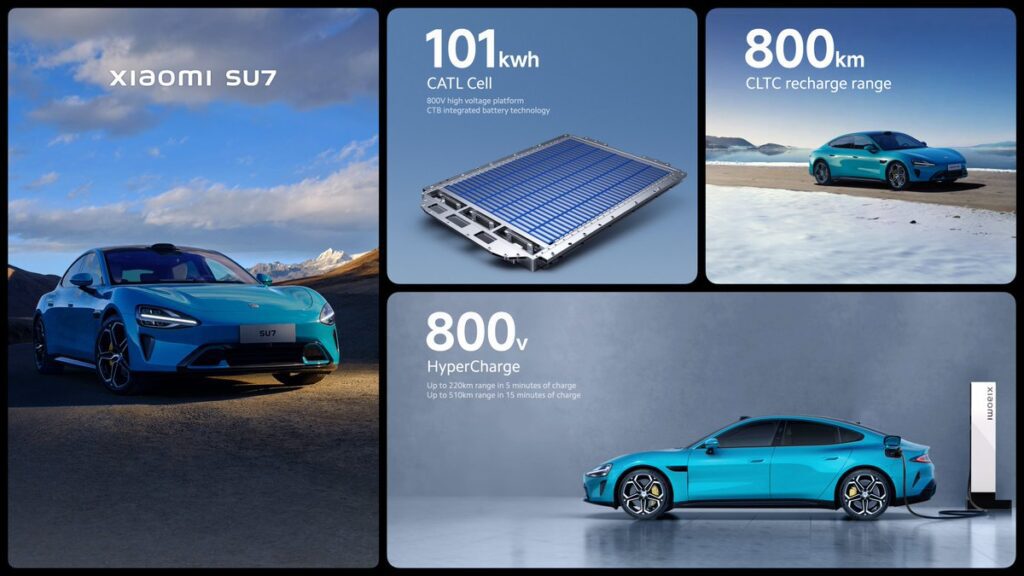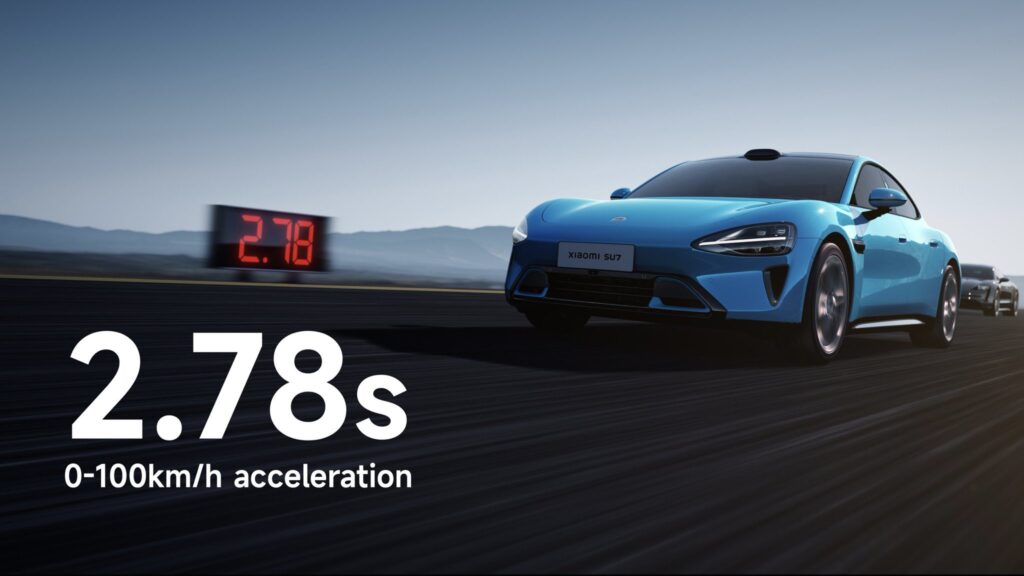Chinese technology company Xiaomi has just announced its first electric car, the SU7 and should send terror through the hearts of legacy auto. The company is taking its experience in phones, and scooters and going to a whole other level with the introduction of a very impressive EV, at least on paper.

Performance
The SU7 will be offered in two specs, a standard RWD model which offers an impressive 5.28s 0-100km/hr time, while the flagship SU7 Max is a dual-motor variant that offers an insane 2.78s 0-100km/hr time. To put that into perspective, it’s half a second faster than the already ridiculous Tesla Model 3 Performance.
The top speed of the SU7 Max is 265km/hr, with a max horsepower of 673 horsepower (494kW) and 838Nm of torque. The RWD model has a top speed is a still very impressive 210km/hr, much more than you’ll ever need on the road.
During the announcement, Xiaomi shared three e-motor designs, which showed their direction in the next years, clearly indicating they want to be a performance brand.
Currently, their production motor is what they refer to as a HyperEngine V6, which spins at 21,000 RPM and expect to move offer version 8 by 2025, which improves that to 27,200 RPM, so expect Xiaomi cars in the future to go even faster.
The top-tier of this, features carbon-sleeved rotors, for a motor that could spin up to 35,000 RPM.
In a promotional video of the SU7, we also see active aerodynamics, with a spoiler that raises up from the rear of the vehicle at higher speeds to increase downforce.
Part of achieving this performance is optimising the production and reducing weight. Xiaomi has leveraged a now familiar manufacturing technique of single-piece casting in the vehicle to reduce parts and cost while increasing the manufacturability, something Tesla led the way on and the secret is now out and being replicated.

Battery and range
The Xiaomi SU7 Max uses a large 101kWh battery pack to achieve an 800km range using the CLTC standard. When we convert this to the more familiar WLTP standard, we should expect between 640-680km, very healthy indeed. While not official, a conversion to the EPA standard, we expect a range of between 576-612km.
The SU7 RWD offers a 668km range (CLTC), suggesting a smaller pack, although the size is not disclosed for this model.
Given anyone can throw a larger pack in and get a longer range, the biggest question that remains, is what the price of the car is, a critical component in determining the value for money on offer here.
As with many new cars, the SU7 uses an 800V architecture and a large 101kWh battery pack.
Storage
The front and rear storage looks impressive in the SU7, offering lots of space (105L) under the bonnet and another 517L in the rear. While its a sedan and not an SUV, this should provide enough storage for many families to travel in comfort.
Interior Design
Inside the cabin, Xiaomi offers a modern, centre-mounted display that now feels familiar, complimented by a row of physical buttons below. There’s the now commonplace glass roof to add a feeling of extra space and provide additional headroom for taller occupants, and the experience (and leg room) in the rear seats look incredibly comfortable.
There is one shot in the press materials that shows the back of the rear seats with displays on, it’s not clear if this is an option, or available on the top-spec, but this does look like a better option (although higher costs) than having a single display for the rear passengers between the knees of the person in the middle rear row.

Autonomy
During the EV technology launch, Xiaomi showed off their Autonomous Driving technology known as Xiaomi Pilot, which features a hardware platform that includes High-definition cameras, Lidar, Millimeter-wave radar, ultrasonic radar, and more.
Their AI stack includes a Super-Resolution Occupancy Network, AI Road Modelling, a Behaviour Prediction Model, and more.
They also show a Data Engine that features a Shadow mode and the data is trained on a Supercomputing training cluster. If this sounds a little familiar, it certainly reflects a number of technologies Tesla has put in place over the past few years, although clearly there’s a strong difference in the hardware approach between the two companies, with Tesla relying on a vision-only model.
Autonomy efforts are really hard to gauge from a spec sheet, so to help with that, Xiaomi provided a video of Pilot self-driving through a multi-story carpark and parking itself, something Tesla’s FSD beta can not do today. Impressive.
The design, the tech, and the specs are all very impressive from Xiaomi, particularly given they lack a history that extends hundreds of years.
An outstanding question in the auto industry is if the auto companies can learn technology faster than the tech companies can learn cars.. I think we started to learn that answer with companies like Tesla, but clearly, companies like Xiaomi are showing tech companies have a much better ability to learn the car side.
American auto industry better hope that those Chinese tariffs stay in place because vehicles coming out of China like this and ones from BYD, XPeng and others are likely to steal massive market share from the incumbents, particularly in an incredibly price-sensitive macro environment.
I hope we see the Xiaomi SU7 and future vehicles make their way to Australia, when the competition arrives, the consumer wins.
Now we just need the most important spec of all, the price.
>>> Read full article>>>
Copyright for syndicated content belongs to the linked Source : TechAU – https://techau.com.au/xiaomi-su7-max-offers-a-stunning-2-78s-0-100km-680km-range-can-park-itself-in-a-multi-story-carpark/































